

Embenchime River
9:35 p.m. Siberia 9:35 a.m. EST
74°F High 46°F Low Sunny
Dr. Ranson reports:
Today we chugged down the river. We’re heading towards the junction of the Embenchime and the Kochechum Rivers. Just before we get there, we have a series of plots we really want to measure. That confluence is still a long way away – about 75 kilometers, or just under 50 miles, in a straight line. Because of the twists in the river, that means we’ll travel 1 ½ times that much. I heard we are now averaging about 6 ½ miles per hour. Compared to other days, that’s pretty brisk.
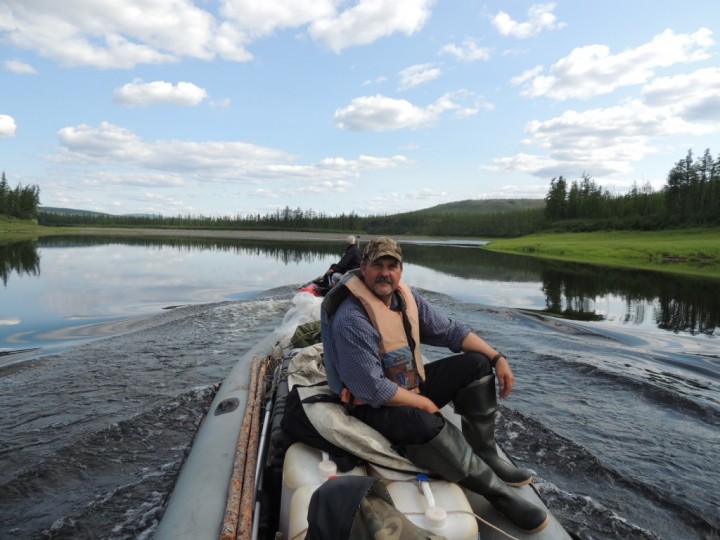
The rising river level allowed for easier passage along the Embenchime today. Here Jon rides in the front of the middle boat. He is sitting on tanks filled with gasoline.
The water level has risen, thanks to the rains. There are still riffles and shallow water at most turns. We still have to get out and haul the boats over the shallows. We still hurt our boats on the sharp rocks, too. We tore the bottom of the white boat again. So, we still make repairs every night. But – we’re making progress. It’s still hard – but it’s better.
Our next goal is what we call Plot 16 and 17. These areas looked like they had a lot of accessible GLAS footprints, and we think it will also be good for the G-LiHT measurements. We’ll spend about a day and a half there, working our little hearts out, to get all the data we can acquire. Then it will be full bore to Tura to try to reach our plane by July 23. That sounds so dramatic, “full bore”, like we’re in cigarette boats and going to fly down this river! Not quite – we’ll be in our rubber boats, chugging along.
Today we saw our first spruce. Spruce like warmer and milder conditions than larch, and can’t survive in the farthest northern regions. In recent times, however, spruce is moving further north and at higher elevations in many places. Slava has said that, in the valley to the south of this one, he has seen some spruce growing. But he did not know it was growing in the Embenchime valley.
We are only seeing a few spruce, here and there. We have seen them on the southeastern part of the river, the sunny side of the river. I confirmed a small tree, maybe 10-15 years old, growing right on the southeastern shore. We also believe we saw some older trees, further upriver. But they were distant and we didn’t have time to stop and confirm.
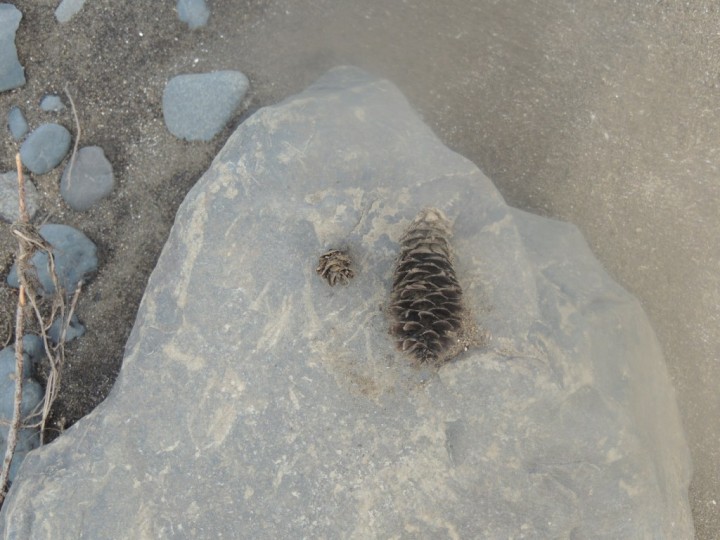
Siberian spruce and Siberian Larch are both conifers, and both carry their seeds in cones. The larch cone (left) is small and has small, winged seeds. The spruce has a larger cone. Spruces, which are dark-needled conifers and retain their needles all winter, cannot live in the extreme climates that suit the deciduous Larch. Spruce has recently begun to be found living further north and at higher elevations than its historic range.
When Siberian spruce (Picea obovata) begins to grow where only larch once grew, it suggests a warming climate. Larch is an extremely hardy tree, and lives in harsh, cold, dry and wind-blown conditions where no other tree can live. It is also very shallow-rooted, so it is well adapted to the far north, where permafrost keeps the land just under the surface frozen year round. Spruce wants to root more deeply, than is possible in frozen soil, so they don’t do well in permafrost. When spruce encroaches on larch, it can be a clue to permafrost melting underground.
As we move further south, we see other signs suggestive permafrost degradation. We’ve seen a few areas of “drunken forest”. That’s a rather poetic term for a forest stand where the trees no longer stand upright, but lean at odd angles – some to the right, some to the left. This odd-angled forest gives the appearance, I guess, of a group of drunks walking home from the bar, unable to stand up straight. I don’t know about that, but I do know that drunken forests have nothing to do with alcohol. It has to do with soil. Where the permafrost melts and the soil warms, the shallow roots can no longer hold up the taller trees, so they “slip”, ending up growing at odd angles.
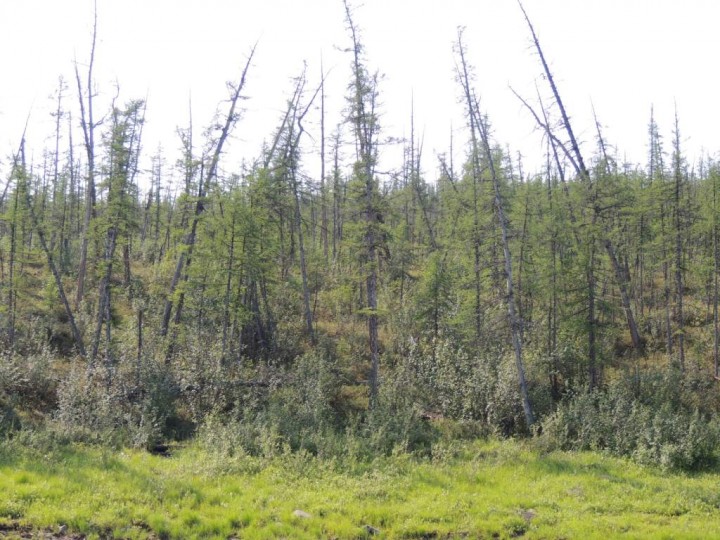
Larch trees have shallow root systems, and often grown in thin layers of soil that lay above permafrost. When permafrost begins to melt, the soil begins to shift and can no longer support the trees. As a result, the trees begin to lean, usually in various directions. This is known as a “drunken forest”, because the trees can no longer stand upright.
We also are seeing slumps and landslides along this section of the river. When permafrost lies below a layer of soil, that permafrost is frozen and firm – and it doesn’t easily shift or slide. As it melts, however, the soil layer deepens and becomes moist and soft. The weight of the trees and vegetation can make the soil sink or slide, depending on topography and soil depth. If the slope is steep, large landslides can occur as permafrost melts. We’re seeing both slumps (small sagging areas) and landslides as we move downriver.
There was a very curious thing I saw yesterday. I saw a little bird, with speckles on its breast and a fairly heavy bill. I thought it looked like a thrush of some type. It was a remarkable little bird, so I spoke to Slava about it. He said I had described a “Cedar Bird”, so he thinks that is what I must have seen.
The Cedar Bird is a curious little bird, and if that’s what I saw, it’s even more curious that one is flying around this far north. It has a symbiotic relationship with the Siberian pine, a southerly species of tree. “Cedar Bird” is a local name. The scientific name is Nucifraga caryocatactes and is better known as the Siberian Nutcracker or Spotted Nutcracker. Its favorite food is the seed, or nut, of pine trees. The Siberian pine has a large seed, and it is eaten by the locals as a tasty delicacy. The Cedar Bird competes with people for this resource – so sometimes locals aren’t too fond of Cedar Birds. They are friends of the pine, however, because the bird loves the pine nuts so much it gathers a lot more than it can eat, and caches the excess to come back to at a later time. Oftentimes, the cached nuts are forgotten – and new pines can grow from them, often far from the original seed tree. The Cedar Bird really helps expand the distribution of Siberian pine.
The thing is – this is not where pine lives. The climate is much too harsh. But the cedar bird is very tightly associated with pine forests – it does not like to each much else. The one I saw might be a just-passing-through migrant. Or I might have seen something else. But if it was a Cedar Bird, then does that mean pine are also close? Or is adapting to eat the seeds of spruce, as well? I have no idea – but these seem to be interesting questions to ponder.
I’ve also seen some interesting bird behavior here. We’ve seen quite a few geese here. I believe they are a type of Bean Goose – small, active brown geese that live in Asia and Europe. They are breeding here, and are swimming along in multi-family groups, with several adults taking care of a large group of chicks, in what looks like cooperative parenting. When we get too close to a group, one of the adults will rise up and start running across the water, thrashing its wings on the surface and making quite a show. Meanwhile, some of the other ducks – we like to call these the “nanny ducks” – quickly and quietly herd the little ones into a group, and shoo them to the river side, where they all run up the bank then suddenly all disappear in the woods. About that time, the distractor duck finally gets aloft and flys away. We’ve seen this happen repeatedly. It’s an interesting survival strategy.
Yesterday we went by a hunter’s cabin. As remote as we are, civilization is not very far away, and people do use these forests frequently. The cabin was well kept, and it looked like it has been recently used. I am told that this area is well-loved by hunters, especially in the fall and winter. They will trap sable, hunt caribou, and probably will be gunning for the geese and ducks that we’ve been seeing, too.
The hunter had a nice, nearly new, snowmobile sitting in a shed, waiting for him to come back this winter. I couldn’t image how someone could get a snowmobile up here – the river is too shallow to allow shipping, and there are no roads nearby. Slava said he most likely waited until the river was solidly frozen in the winter, and then rode the snowmobile up from Tura. That would be over 300 kilometers (190 miles or so), on snowmobile in the middle of the Siberian winter. Doesn’t sound like that much fun to me. I’ll stick to summer, even if the river does run shallow at times!
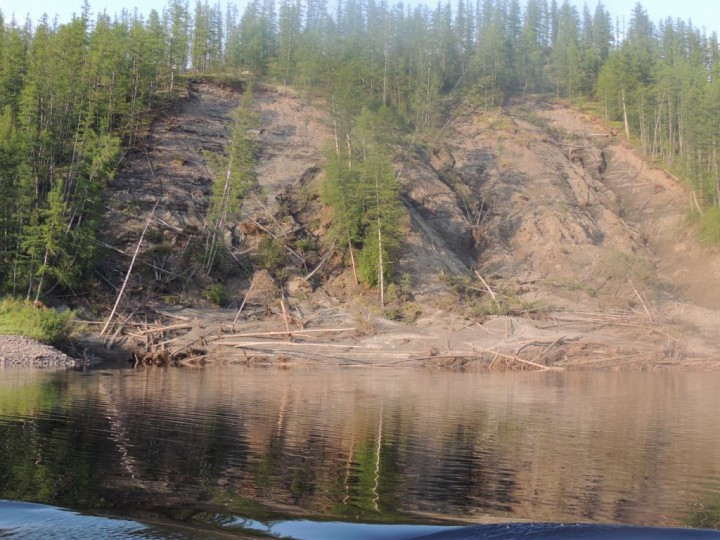
A landslide. As permafrost begins to melt, the land becomes unstable. When this happens on hillsides, the topsoil and trees often end up sliding downhill, as in this image. As the team heads down the Embenchime, sights such as this are becoming more common, especially on the sunnier south side of the river.
We’ve seen clear evidence that the shallow, sleepy Embenchime, as we have experienced it this trip, can run both deep and furious. This river will freeze in the wintertime, when temperatures plummet and snow piles up all around. In the springtime, as the warming sun rises higher in the sky, the snow begins to melt and the ice cracks. The runoff raises the Embenchime, and it pours down from the mountains into the Kochechum very high, carrying chunks of sharp ice as it roils along. That ice scrapes the barks of the trees as it passes, and a trail of scars can be found along the river. These scars are about 10 feet high in some places – way over my head. The idea of this little river flowing that high, that fast is hard to imagine, but the proof is here. I’m sure it would be quite a sight to see in the melting springtime.
Our food has become more about noodles and canned meat than fresh fish. Slava caught a nice pike, but other than that we haven’t seen much fish since the river started to rise. I haven’t had much desire to go fishing this trip, but it would be good to have fresh protein, so I will gather up my fishing gear and try to help out before bed tonight. We did eat some fish today – from a can. We had meat and beans and ikra – all out of cans, too, for lunch. It was a no-frills affair. We each had a spoon, and we had a variety of different cans opened, and all shared. That’s how lunch is done, sometimes, on the river when you are trying hard to make time. I’d rather eat cold canned food than miss my airplane – or miss meeting our measurement goals.
Embenchime River
9:30 p.m. Siberia, 9:30 a.m. EDT
65°F High 54°F low Rain
Dr. Ranson reports:
We’re at the end of another long journey on the Embenchime. We’ve covered 38 kilometers in a straight line – with the twists and turns, of the river, multiply that by about 1 ½ – so it’s more like 57 km. We left here about 10:20 this morning, and arrived at our camp about 8 p.m. That’s a long day. A little over 9 ½ hour to get that far.
It rained all night long, a very persistent pattering down. We planned to wake up at 7 a.m., bright and early. For some reason I was stirring about 6:30, and listened to the rain, disappointed that it would be another soggy day. But, at about 6:45, right before everyone was due to get up – the rain stopped! What a coincidence! We welcomed the rain, because this region needs water. But we’re also quite pleased to be dry.
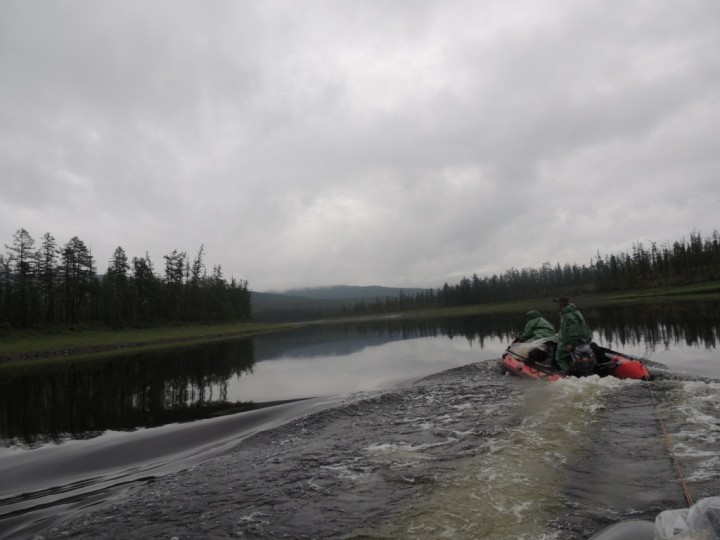
The river was higher and kinder today, allowing the scientists a little rest and time to think. Here the red boat takes the lead and powers the group down the river. There were still many shallows, especially in the river bends, and the boats again sustained some damage.
Not that it stayed dry all day. Just as the river has been working us hard, the weather teased us today. We had a nice start to the day, but then, around noon, it started raining again. Again, a steady rain – no storms, no drama, just soaking and relentless rain. Then it quit about 5 or 6. The peeked came out and the clouds began to drift off. We began to hope for steadily better weather.
Around 8 p.m., we saw a decent campsite – a rocky shore – and since we like to sleep on rocks (actually, that’s our only choice here!), we pulled over and began to set up camp. The sky was blue, and a nice little breeze had popped up. My tent and sleeping bag had gotten a little wet last night, so I laid them out on the rocks to dry, and so did the others. We were pleased – we were going to have a dry night!
Just as we were feeling pretty satisfied, this little rain cloud came up, very fast – right over our stuff! It poured down – and we just stood there – staring. What else could we do? It was a little cloud, very localized, and the rain only lasted five minutes. Just long enough to get us nice and wet for the evening. I guess we get reminders of exactly who is control here – and it is not us.
Now it’s cloudy, but no rain. It’s very peaceful, and the ever present mosquitoes seem to be rather calm, as well.
Our Russian colleagues are cooking dinner. It smells very good. Our diet has changed from fish to spaghetti. We’ve had it three meals in a row now. Noodles and tomato sauce, with canned beef most of the time. We haven’t had much time to fish, so we’re back to the canned things. Every lunch, we’ve each had our little Snickers bar. Pasha always brings them along for us, and makes sure we get our candy bar every lunch time. I had to admit, I’ve developed a little bit of addiction. It’s a treat, it’s sweet, and I look forward to it. They are real Snickers bars – but they aren’t American. They have Russian writing on them. I don’t eat candy much at home, but I think these taste just like our American version.
Well, today, we had a little bit of a tragedy. At lunch time, we laid out all of our food, and I looked around – and there were no Snickers bars at all. Pasha has a trained – we stop, we lay out the food, and he gives us a candy bar. We’re not quite Pavlov’s dogs, but we’ve become, quite unwittingly, something like them – you could call us Pasha’s scientists, I guess. The food was all there – but no candy. Then Pasha shook his head – no more Snickers.
Oh – that was hard! I was disappointed – unreasonably disappointed. I know the expedition is hard, and I just deal with it all. The wet, the hot, the bugs, the paddling, the blisters, the sore muscles, the rocks we get to sleep on – no real problem. But – no Snickers? That’s tough! Guoqing saved the day, today – he had a few Hershey’s bars to hand out. They had English writing on them, and he’d brought them from home. However, I have a suspicion that we have now eaten all our treats. That’s really rather sad.
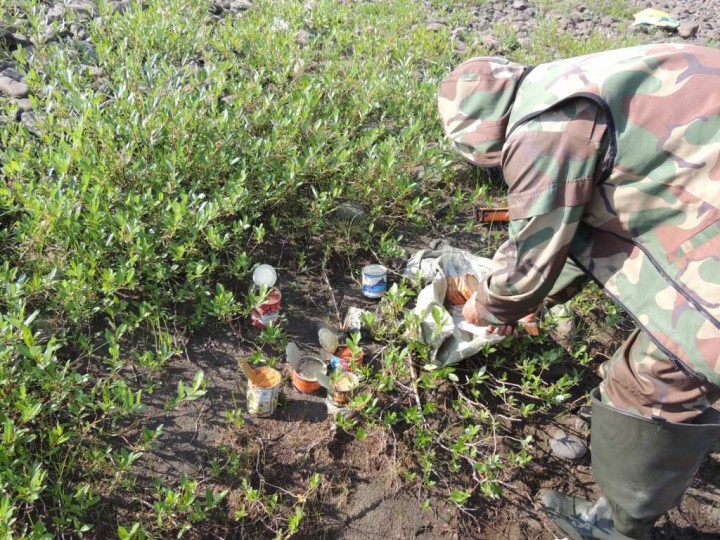
Here Pasha lays out a typical lunch – a smorgasbord of canned delights. Along with the canned food, lunchtime usually ends with a daily treat – a Snickers bar. Today, the stock of Snickers has seemed to run out, much to the disappointment of the scientific team.
This whole trip, we have seen no active forest fires burning. But it’s easy to see that this area has burned many times over the last many years. Almost everywhere we see signs of past fires. An area near hear is relatively freshly burned – about 10 years ago. That seems like the most recent fire scar we’ve seen.
That said, the floors of these forests are full of moss, and lichen and lots of dry things. If there was a big lightning strike, it could ignite quite easily. Or if people were careless with fire, of course. But there are not a lot of people up here. Most fires in remote northern Siberia, where people are few, are naturally ignited by lightning. It is thought that in more populated area, human activity is the driver that starts most fires.
The forests are quite stunning here. We’re not seeing dramatic rock formations, like we have on expeditions further north. What we have here are hills full of green trees, and lots of basaltic boulders. And the clear waters of the shallow Embenchime. Taken all together, it is quite a pretty place – if you like trees, that is.
The river is a little fuller today – the rain has helped. Still, there are a lot of shallows. We’re getting a rhythm down, and learning to work with the river and with each other a bit more efficiently. We jump out, lift and pull the boats over the river, and soon are on our way again. I think we are starting to make up some time. If we can get one more really good day on the river, we will be back on schedule.
Yesterday’s rain helped fill the river, plus we passed three or four small creeks, tributaries to the Embenchime, and that helped as well. We went through an area with six or seven tight bends – almost a corkscrew. At each bend, we have to get out, we wear waders so we’re always ready to jump in the river, if we have to, and we then we pull or carry the heavy boats, until we get into deeper water. The quick bends just wear us out.
The white boat had a big hole in it, today, again. We still are getting sideways on dragon’s teeth, and still scraping the bottoms on the rocks, and the boats get hurt. We haven’t lost any equipment, and we haven’t gotten anyone hurt. We’re all doing great. The boats, however, stay pretty unhappy. We’ll have to fix them tonight or tomorrow. Then we get back on the river for another day’s ride. We have places to go, and trees to see.
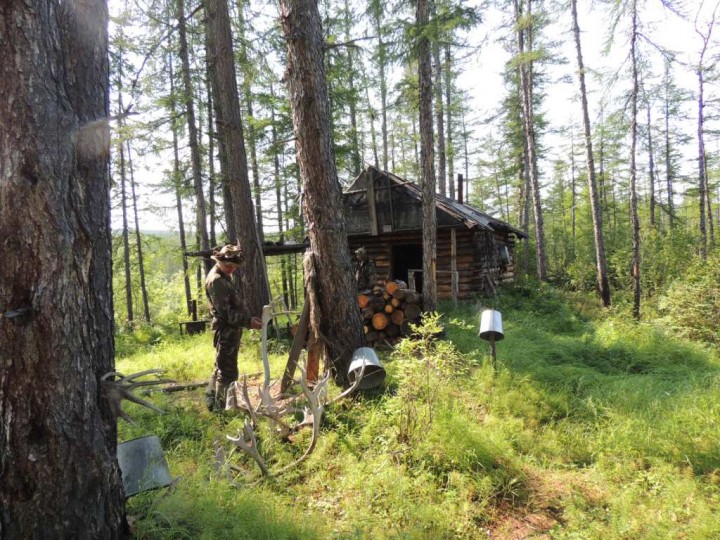
Even though this is a really remote part of the world, people are beginning to move into the forest, and have their direct impact on the land. The forests here, however, are connected in a very real way to the rest of the Earth, and to each individual, and to each human community. What we do in our lives and our communities affects these forests, and the ability of these forests to take in carbon affects our human communities. The bond is invisible, but it is real. We are all connected.
The river was kind today, so I had a little time to think. I was thinking about how much carbon these trees absorb. They have the power to absorb some of the addition carbon dioxide that people are putting into the atmosphere. They are cleansing what we are polluting, so to speak.
But the trees don’t know they are doing that – they have no way to understand how much carbon we’re putting into the atmosphere. The trees just are living here, and they just respond to conditions as they change. It’s an amazing system – that these trees can change how they live as conditions change, and they are one of Earth’s homeostatic mechanisms, one of the players in the feed-back loops that help maintain conditions on Earth, so that it stays suitable for life. Of course, the forests have their limitations to mitigate changes, but they play an important role in Earth’s stability as our home.
It’s really true that we are all connected – these trees and the people at my home. We all share the one Earth. And the trees in the boreal forest respond to what we do, and are mitigating what we do. It’s kind of amazing – who could imagine that the trees in these forests, so far away, are connected to my home, and your home? But it’s true, in a real sense. And the more we study, the more we discover just how connected all life really is.
Not too long ago, scientists tended to look only at their little field, and focus on their own questions, with minimal interactions with other Earth systems. But now, scientists are trying to think of the Earth as a full system – land, ocean, atmosphere. And we are, more and more, realizing that the interactions are very complex, very intricate – and very important.
It would be good if people would think of the Earth as a system. It would be good if people could feel connected to the entire Earth, not just their own home. In a real sense, there is an impact on what we do in our world – in our cities and our farms and our businesses – there is an impact on the rest of the world. It impacts the forests, and the ice sheets, and those changes, in turn, impact us. It’s really true – we are making choices of how we are going to live – and how we choose to live has a profound impact not just on each of us – but on our entire Earth.
I’ve also been thinking of the cycle of life. I’m here now, and I’ll go home soon. The birds are here – they will go south soon, like they do each year. The forests are growing here – but soon they will burn, then grow again. There is a cycle that repeats.
At the same time, things are changing. Forests burn more frequently. Migratory patterns seem to be changing. People come to these boreal forests more frequently, and people are pumping out carbon at an unprecedented rate.
As the climate warms, these forests may exploit their potential for growth, and expand. As the climate warms, the permafrost will begin to melt, the carbon-rich soils will decompose, and carbon and methane will begin to enter the atmosphere more and more. The forests, at first, will expand, and take in more carbon – but can they take in enough, enough to stabilize the system? There is potential for huge change – in our homes, and here as well. This ecosystem is pretty pristine, and we can see the changes as they begin. We are seeing signs of change, and have for the last several years. But the big change is not really rolling yet. It’s so important to study this area, to learn what impact it has in the balance of our Earth, and how we are impacting both these forests and Earth’s balance. I encourage everyone to begin to realize that, in fact – we really are connected.
Embenchime River
10:45 p.m. Siberia 10:45 a.m. EDT
71°F High 42°F Low Steady rain.
Dr. Ranson reports
Tonight I’m calling from my tent. I’m in my sleeping bag already too. I like it here, because it’s dry.
Outside, it is raining, and everything is wet. I hear rain dripping on the tent, and all around. It’s actually loud, but it is also comforting. It is out there; I am in here. All is well..
This morning I woke early, started the campfire and worked around camp as the others started joining me. We had a breakfast meeting to figure out how to deal with the day, and the rest of the trip. We’re running late, but we needed to work this area as hard as we can before moving on.

Today was rainy and overcast. The trees appeared as strange shadows at times, with many interesting shapes.
We’re camping close to a line of GLAS footprints. Because they go upslope, and GLAS isn’t very effective for vegetation on steep slopes, aren’t the best plots in the world for us. But they are the best plots we can reach – and so that’s what we will do! We came to Siberia to learn what we can – and we’ll gather all the data we can. So today, job number one was to get out in the woods, get into the hills, to measure the trees in that line of GLAS footprints.
And that’s exactly what we did. We had a long day but we managed to complete 11 GLAS fooprints – a pretty good day’s work. We also were able to add 8 non-GLAS sample plots. Those will really help with the G-LiHT instrument calibrations when it flies here next year. So, at the end of the day, we’re really please with ourselves. We’ve not only gotten a nice dataset of GLAS plots already, but now we have a really good dataset for G-LiHT too.
Slava had a great day, himself. He located more excellent sites for his fire return studies. He’s found spots on both side of the river, so he has a richness of samples now. We still want more of biomass measurements, but I think, as far as Slava goes, he’s got more than enough data for fire return to just pull up roots and head back to his lab. If he were here without us, I suspect he’d be tempted to head right back to Krasnoyarsk, start his analysis and pretty soon start turning out some fascinating papers. But here we are – and we want more data. He’s quite willing to stay with us and help out. He’ll probably find quite a bit more before we are done, as well.
The morning broke overcast, maybe even slightly gloomy. Rain began to fall in earnest in the mid-afternoon, around 2 o’clock. It is a steady rain. No big wind, no lightning, no drama. Just steady, persistent rain. The kind that gets you wet, no matter what. And so, most of the day, we were wet.
Every expedition, there are days like this. It’s no fun to sleep wet, so I long ago learned to squirrel away one set of dry clothes in my tent, preferably inside my sleeping bag, and both inside a dry bag. It’s okay if you are wet in the daytime – no one is going to melt, and maybe rain might help us smell a little better. But wet at night makes for a bad night’s sleep.
We’ve been rained on three or four days already this trip, but those were only short rains. Today is the first really steady precipitation, and it’s very clear this region needs it. Rain will be good for the plants, and maybe it will be good for the river, too. It would be a God-send to have this river rise, so we could escape some of the rocky shallows. No one is complaining about the rain.
We continue, however to fret a bit about the time. We have to really get moving to get back on schedule. We can’t be fighting the shallow Embenchime like we have been – just don’t have the time. If we can’t move faster on the river, then we risk abandoning further sampling.
We lost two days of this expedition already. One day was lost because of flight delays due to the fires – a result of dry and hot conditions in the forests of central Russia. We lost the other day due to a very low Embenchime – the result of a dry spring and winter in the mountains nearby. The common link for both of these has been the dry, hot weather across Russia. I hear that the United States is in drought, too. We had a heatwave in the US as we left to come here, and another is in the making now, I am told. It’s rather disturbing. It seems like an awful lot of the world is hot and dry right now.
I guess those of you at home might be wondering what the big deal is – so what if we come off the river a little late? All I can say is that it takes a lot of planning to get flights that connect well. It can be a challenge to get all the way from Tura back to Dulles airport in Virginia. If you miss a flight, you could be left waiting a long time, in some airport along the way. Waiting around is a major waste of time – and money. It is much better for us to leave as scheduled, if possible.
Well, there is no use to fret in the rain. Tomorrow we will get back in our boats and see what mood the Embenchime is in. It’s still possible we can move along quickly, and reach all of our goals. Including a timely return!
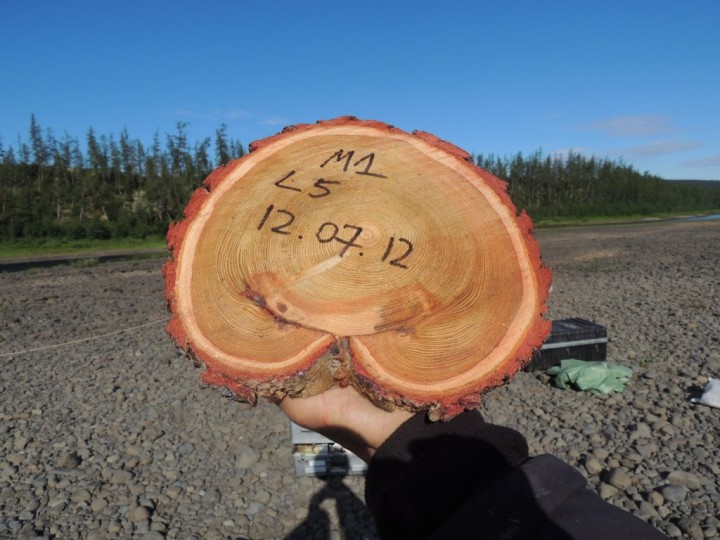
The forests in this region have burned in the past, although no active fires have been seen. It is a very rich area for collecting fire return data. Here is a sample collected by Slava and Sergei on July 12. A fire scar can clearly be seen. The tree has made an effort to heal over the fire scar. These samples are carefully examined in the lab not only for fire scars, but for tree age and growth patterns.
I had an interesting experience today. We were in one GLAS sampling area, measuring trees. I was recording data, while Pasha and Guoqing were making the tree measurements. They called out the species, diameter breast height (dbh) measured, and comments on the trees, especially if the tree was dead and/or had broken branches. As they called out the dbh measurements, pretty soon I started recognizing the same numbers, nearly exactly, over and over. In fact, there were about three sizes of trees, all very nearly the same dbh, with very little in between. There were really big trees, medium sized trees, and also a group of pretty small trees. No continuum at all – just these three sizes.
Not only that, when I started looking more closely, each of the size classes shared not just dbh, but physical attributes. In other words, all the big trees were “dead” and their branches were broken off. The middle sized trees were “dead”, but they retained their branches. The smaller trees were all green, living trees. Well, a very few of the large and mediums were alive too – but darn few. There was a very clear pattern here.
We looked the stand more closely, and we noted a lot of fire scars. Without a doubt, fire burned – and mostly killed – two separate generations of trees here. The first fire burned about 70 year ago, and it killed the largest trees. Trees began to fill in, and grew for a half-century or so, then, about 15 years ago, another blaze decimated this stand. Now there are a lot of dead trees, a very few survivors, and a very thick stand of small, living, green trees. The small trees are all about fifteen years old.
It was quite interesting to see the data come in, and recognize the pattern. Normally burn scars make patterns which are pretty visible in the forest. But this stand was very thick, so it was hard to see the big picture. Once we started looking, we could see the pattern, sure. But it was the data that helped us recognize what had happened. It’s a good illustration of the power of collecting objective data. Data can make things quite obvious that one never would recognize in any other way. But, of course, we have to also say that we have not fully analyzed this data. We only have an impression – and as sound as it seems, we’ll need to take the data back to the lab do a full analysis before we can be certain that our impression actually is statistically significant.
The forest varies a lot here, in terms of size and fire history. There was a large, fully mature stand with absolutely no regeneration. That stand likely had not seen any fire in a very long time. Then there were places where the young trees grew very, very thickly, with just a very few living large trees scattered here and there. Those areas are suggestive of a very recent fire. We also saw thick stands of medium sized trees – about 10 cm dbh – probably there was a fire there, but it was further in the past.
The range in tree sizes we found today ran from about 5 centimeters (just less than 2 inches in diameter), to about 35 centimeters in diameter. We don’t measure anything less than 5 centimeters. Why? First of all, it takes a lot of time to measure the really tiny stuff. But mostly because studies have shown that there is a very low percentage of biomass in any given plot that measures less than 5 cm dbh. This is shown in the literature, and is accepted – it just doesn’t pay to measure the really tiny stuff.
In Maine, where the forest has repeatedly been measured, we decided to look at the percentage of forest biomass between 3 cm and 10 cm. We used historical data against our new data. And we found that the biomass found between 3 cm and 10 cm makes up only about 8% of the total forest biomass. That’s not a whole lot of the entire picture. I don’t have figures for average biomass less than 2 cm, but you can see it would likely be much less than that 8% – so we just don’t feel we need to take the time to measure each little sapling. We do note they are there, and we note the species, so we can take the presence into account in our models, if we feel the need. We don’t ignore anything – we just try to make the most of our time.
Time – yes, time is precious. It’s expensive and difficult to get time in these forests. With the delays, time has become our enemy. When we can get to our plots, we really do fantastic – the team is working extremely well, extremely efficiently, and our spirits are bright. We just need time – and I don’t want to share the time with the shallows of the Embenchime. Well, we’ll see how it goes. Tomorrow we are up early and back on the river.
Embenchime River 66° 2 min N 97° 49 min E
11:30 p.m. Siberia 11:30 a.m. EDT
71°F High 44°F low Sunny
Dr. Ranson reports:
We fought the river again today, but in the end, we have been successful. We’re now tucked away in camps – the one we wanted to reach yesterday. Again, our trip was a long struggle against the shallows and small rapids. Each spot is about 50 to 100 feet long, and filled with rocks. To get around them, we have to get out and pull the boat. Slava calls these rocky ripples “dragon’s teeth”, because they are sharp and will eat our boats if we let them. We’ve been careful, but the bottom of our boats have suffered, anyway.
We left camp late today, about 2:30 p.m. We got up early, but there was work to do, such as repairing the boats from yesterday’s rough river ride. We spent over 6 ½ hours on the Embenchime today, to go about 17 kilometers straight-line down river. Because of all twists and turns, we actually travelled 20 or 25 kilometers (12 to 15 miles). But still, that’s something like 4 or 5 kilometers an hour – that’s just two or three miles an hour. We could walk faster than that! But we have too much gear to carry on our backs, so that’s not an option. We’ll stick to the boats, and hope for deeper channels.

At every turn in the Embenchime, the water becomes too shallow for boats to float, so the scientists must get out and drag the boats over the rapids. In some of the shallows, sharp rocks form a formidable challenge. These rapids have become known as “dragon’s teeth”, for their ability to bite the bottom of the boats, and cause damage.
We were fortunate in our campground last night. This morning, Slava walked over the hill, and discovered an area where fire had burned about 60 years ago. This morning Slava and Sergei worked that area, collecting samples for the fire return studies. He was quite pleased, and gathered a good deal of useful samples.
Collecting data for fire return studies is a bit more invasive than our tree measurements. To learn a tree’s history, unfortunately, the tree must be sacrificed. We need to collect a disc all the way through the truck, so that we can count the age, look at growth rings, as well as to see when fires singed the bark. We get a tremendous amount of information out of each sample, but Slava makes careful selections, because we don’t want to be cutting down the forest. We sample very carefully and selectively. When we measure trees, we take measurements of every tree above 5 cm in diameter in our study plot. When Slava takes fire return samples, however, he will take only one or two carefully selected trees in the forest.
In order to gather his samples, Slava begins by locating an area that appears to have been affected by fire in the past. He likes to find trees that have a burn scar visible on the trunk. That way, once the sample has been collected, we have a positive date for one fire. He can then carefully analyze the growth pattern, and if there are any other fire scars inside, he can date the years between the fires.
Once a tree is scarred by fire, it keeps that mark for life. As it ages, the trunk will grow over the wound, and it no longer will be visible on the living tree. But the tree carries that mark, inside, for life. That’s what Slava is looking for – the internal scars to compare against external scars.
When we look at a forest, we can often tell if a fire has passed by in recent years. We can’t tell the distant past – that’s why we need the fire return samples. But we can tell if fire has scorched the trees in more recent times. The biggest clue is when we see a stand of scattered old trees that are dead or dying, surrounded by a thick growth of younger larch, all of the same age. Because fire damages or kills standing at the time of the fire, as well as provides great conditions for larch regeneration, a few years after a fire you get this pattern – a few sad old trees, surrounded by vigorous new growth.
We actually are seeing a lot of these spots along the river – areas with lots of big trees surrounded by heavy larch regeneration. So this area definitely has burned in years passed, but not very recently. The new trees look young and small, but it takes a long time for them to grow in this area, with the cold and harsh winters. Near our campsite, the new trees look pretty small, but we are estimating they are at least 60 years old. As the climate warms, however, we expect to see the regeneration grow more quickly. It’s been warming in this area for the last several decades, so we have to be a bit cautious in our age estimations. We’ll confirm the age by counting growth rings on the samples Slava has collected.

Fires are a part of the larch forest ecosystem. Although there are no fires at this time, there is evidence of widespread fire in the past. A fire burned in this location about 60 years ago, leaving scattered large trees dead and dying. A strong surge in new larch growth followed. The post-fire forest is characterized by a same-age stand of young larch, punctuated by scattered old, dead trees.
When a tree dies in northern Siberia, it doesn’t decompose like you would expect. We’re used to the southern climates, where decomposition is relatively rapid. But it’s cold and dry here, and dead trees stand for a very long time. We have written papers on fire return, not on this very spot, but in similar areas in Siberia, where we studies forests where the trees that had died in the Little Ice Age – back in the 1500’s – were still standing. Those trees are still here, 700 years or so later, with very little decomposition. Should the climate warm, we would also expect the rate of decomposition to pick up quickly. The old, dead trees of Siberia are holding a lot of carbon in their trunks. When they begin to decompose, that carbon will be released – one of the many reasons that the boreal forests, which are now considered carbon sinks that help slow climate change – may become carbon sources in a warming world.
We also have studied the line between the forest and the tundra. Trees can only survive under certain conditions, and in the far north, and at high elevations, the conditions become too harsh to support even the tough Larch trees. That’s where the forest – the taiga – gives way to the scrubby grasslands, which is called the tundra. We call this transition zone the taiga-tundra ecotone. We are interested in finding where this line lies today, and how it has changed from the past. We also are very interested in how it is changing.
Because dead trees stand so long here, we can find the tree line at the time of the Little Ice Age pretty easily, by looking at where those long-dead, or “fossil trees” are located. And we can compare that line to the very easily located modern taiga-tundra ecotone.
What we are seeing – and are able to measure and document – is that the forests are now surpassing the historical extent of those ancient forests. Trees are extending further north and at higher elevations that ever recorded before. That’s not just happening here, but also in the Sayani and the Altai mountains – and has been documented in many other places in the boreal forests, as well. The prediction is that as the climate warms, forests will continue to push upslope. This has been clearly happening for the last several decades. Scientists will continue to make these measurements, to track what is happening now, in the decades to come.
As for tomorrow, we plan to stay put and measure. We are close to a line of GLAS plots, and we’ll work those plots. However, it looks like the GLAS line heads up a river and up a steep hillside. That’s not so good. It’s hard to get to the plots, sure, but that’s not the real problem. The big problem is that, because GLAS was created to measure ice, not vegetation, that the GLAS data has some real limitations. It’s not that great for vegetation to begin with, but it’s particularly poor in steep slopes. We’ll get the data, however, so maybe we can learn something that will help us better use GLAS. But we really, really need an instrument designed for vegetation. The boreal forests are really important and we need a tool designed for measuring vegetation. We’re working on the problem – we’re hopeful that the G-LiHT system will prove useful. But our need is very great.
For now, we’ll spend tomorrow making measurements for the old (GLAS) and the new (G-LiHT) instruments, and we’ll look for potential fire return study samples. And we’ll also try to figure out how to get to Tura on time. It’s a balancing act – we have limited time, and we have need for time to measure, and more time than planned to travel.
We also need some time to repair our boats, and to dry out our generator and other gear that got soaked in the boats, because of all the leaks. It’s ironic – now that the data terminal works just fine, we lose our ability to connect because of a wet generator! It will dry, and will be fine. It’s just a communications delay, not a disaster.

Connectivity is prized here – and not easy to accomplish. The data terminal was difficult at first, making connection to the internet impossible or difficult. Today, the generator was soaked by a leaking boat. While it dries, the computer cannot be charged so connectivity is once again impossible. When the internet is up, the scientists will go to great lengths to use it for a few minutes. Here Dr. Guoqing Sun is using the internet. Shading from the sun is required in order to be able to read the screen.
At dinner tonight, talked about the river – its virtues and its evils. The Embenchime is a hard river. It makes us work in order to gain headway. The rapids, the shallow water at every turn, and so very many turns – this is so difficult. We want to go fast, but the Embenchime holds us back.
On the other hand, the Embenchime is incredibly scenic, and very beautiful. Today was sunny, with clean blue skies decorated with white clouds. A few mares tails were wispy in the sky, with high cirrus clouds scattered about. It was warm today, but the waters of the river were cool and refreshing At times, the Embenchime is kind and pleasant. But at every turn, she is also so very harsh.
We’re hoping that we will see more virtues and less evil as we head further down river. There will be some tributaries joining soon, and we hope that will mean more water and an easier ride. But the river will, no doubt, continue be what it is – both beautiful and difficult.
Embenchime River 66.15 N 97.57 E
73°F High 40°F Low Periods of rain and strong wind
11:50 p.m. Siberia 11:50 a.m. Eastern Daylight Time
From Dr. Ranson:
It is near midnight, and we just got off the river. I helped get us situated and safe, but then left the others so I could check in. Dinner is cooking, and it smells fantastic. We don’t always eat regular meals here – but when we do get our supper, it is very welcome.
I realized just a few minutes ago that today is Friday the 13th. In America it’s considered an unlucky date. Many people might say, probably half-jokingly, that it is no time to travel or take risks. Well, although I’m not superstitious, I have to admit that this was not the luckiest day to run the river. No one is hurt, and there were no tragedies. But we struggled with this river today.
The day started beautifully. A bright, warm morning after a crisp, chill night. We ate fried pike and bread for breakfast, then broke camp. We took down the tents, packed all the gear, and then loaded our three boats. We don’t have excess gear – but you can’t say that we pack lightly.
Our goal for today was to reach the next camp, 39 kilometers down river. That’s nearly 25 miles – a good day’s trip. However, that was 39 kilometers “as the crow flies”. Crows have the common sense to fly in a straight line – but the Embenchime apparently has no sense. It twists and turns all over the place. Following the river, we had to travel around 60 km (37 mi) or more to reach the next camp. We didn’t quite make it. We’re camping riverside at least 15 km short of plan.
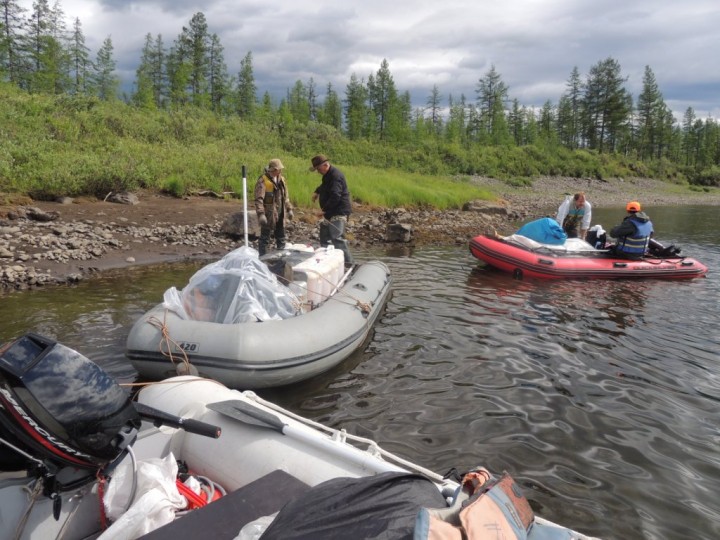
The convoy of boats which carries the scientists down river. The boats travel tied together, one after another in a line. The lead boat is motorized. The second carries the gasoline, cargo and a passenger or two, and the rear boat carries cargo and passengers. Ross and Guoquing board the rear boat, while Slava and Pasha work on the ropes.
The long distance didn’t thwart us – it was the river depth. The Embenchime is about 150 feet wide, and supposed to run 2-3 feet deep. However, the water level is very low. In many spots the rocks were just a few inches under water. Sometimes we could motor along, but often – way too often – we had to get out and pull our boats over the rocky shallows. When we get our weight out of the boat, the boat is lighter and floats higher. With some luck and a lot of work, we were able to pass all of the riffles.
When we found deeper water, I thought it would be relatively restful. But not today. When we are under power, Slava and I sit in the lead boat, with all the rest of the boats tied together in a line. We are like the mother duck, with our two ducklings following behind, one after another in a nice little row. Unlike a mother duck, however, the lead boat is not very mobile. The motor provides power, but under such weight it isn’t very effective at steering. So the guy in the front of the boat – that’s me – gets to act like a human rudder, and steer the boat. In deep water, sometimes this is just a pleasant ride with a little push here and there. But on the shallow Embenchime, it was constant work – paddle left, paddle right, we have to hit that deep channel just right, and we have to miss those rocks! It was quite a workout.
Not that I’m complaining – it’s just how it goes. Slava provided all the steering the motor had in it, and we needed him to run that motor. We all have our own work to do. All I can say is… I’m sure I will sleep soundly tonight.
I’m definitely in a carb and calorie burning mode right now. We’re eating high protein fish dinners, with just a few carbs and a lot of exercise. The Embenchime River Diet sure packs a punch! That reminds me, though – Ross was back in the third boat today. No frantic paddling for him. After today, I think I have a leg up on our weight-loss challenge!
After we’d worked hard to free ourselves of the shallows, and were finally motoring forward relatively well, Slava and I noticed something disturbing. Our boat was taking on water. We weren’t sinking, but we sure had a leak, no doubt from dragging the boat over the sharp rocks in the shallows. The lead boat carries gear that should stay as dry as possible, so we couldn’t keep going. We pulled over, pulled the motor off our boat, and switched it to a sounder boat. Our leaky boat became a cargo boat (most of the cargo can stand getting a bit wet) and after all of that, we were underway once more.
Unfortunately, it wasn’t too long before we noticed water in this boat, too. It had also been damaged, and now was leaking. Once more, we had to switch boats, move the motor, move the cargo, and repack. We couldn’t take time to make repairs – we were too far behind schedule. That meant the cargo, as well as Ross, Pasha, Guoqing and Sergei, would have to ride wet today.
Luckily, we finally found a good spot to make camp tonight. It’s a gravel bar on the river. The stones are smaller in diameter her than our first camp, so I think it will be more comfortable sleeping. The light is very soft right now. The sun went down at 11:20 p.m. It’s after midnight now, and I can still see the sun shining on the hills to the east. Here, in camp, we are in dusky shade. I don’t think it gets darker than this… and it is still light enough that I could read a newspaper. It’s the land of the almost-midnight sun.
Usually the days on the river are the days we can rest and regroup. It’s a time to observe the forest biomes on the sides of the river. And a day of contemplation, too – a time to think about what we’ve seen, what it all might mean. Today, however, there was not much time for thinking, and not much time for observation.
In the quieter times, I was able to notice my surroundings. For example, I found myself noting that my horde of mosquito friends was fairly thin. Don’t get me wrong – there are plenty of mosquitoes here, for sure. But not the overwhelming thousands clinging to everything that I’ve come to expect in this region.
There continues to be more mammal life on this river than we’ve seen elsewhere, in years past. Today we saw a cow and a calf peacefully sharing a long drink from the river. An agitated bull moose pranced back and forth on the bank as we passed by – as if he didn’t know whether to hold his ground or run off into the woods. While he was showing off, a beautiful eagle flew overhead. It was very big, with a solid white tail. I understand that there are several types of eagle that live in northern Siberia, including the White-tailed Eagle. I suspect that is what this was, because it had a very huge wingspan, and the White-tailed Eagle not only has a white tail, but it is said to be the largest eagle in the world.
The forests are still all larch. We see some areas that have been burned in the past and have lots of young trees, but no recent fires. There are a few trees leaning here and there, and a few banks have collapsed. These things happen when permafrost – the permanently frozen soil that lies a meter or so under the groundcover in Siberia – thaws. We’ve seen a few small signs of random thawing, but nothing wide scale.
Yesterday I came across a few juniper plants near camp. I picked a branch, and put it in my pocket. Apparently some of the locals in Russia believe that burning the juniper and letting the smoke go through your vehicle gives safe travel. We didn’t burn any this morning, but maybe we should have tried a little Russian superstition to be a counter to the American Friday the 13th superstition? Maybe we can try tomorrow morning.
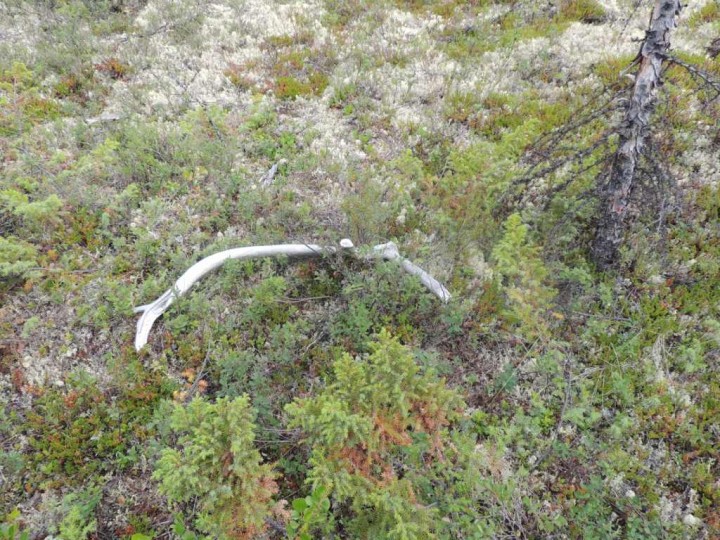
An very old antler, probably from an elk, lying in ground cover next to juniper. It is said in some parts of Siberia that burning juniper, and sending the smoke through the vehicles, helps make the journey safe. After the arduous day on the river today, the team may be tempted to try this ritual before departing on tomorrow’s river journey.
Ah, I was called to supper, and I had to pause. I wasn’t about to miss out on this meal – it’s been a very, very long time since lunch. And will be a long time until breakfast. In honor of the hard day’s work, we had canned beef with spaghetti noodles and tomato sauce. Cow and carbs. It was quite good, and I think we all feel better now.
It’s now after 1:00 a.m., July 14, here. We’ve finished most of our work, and everyone has a few free minutes. Ross has gone to his tent. Guoqing is taking photos, and Slava is taking photos. It’s a spectacular night for pictures. There is a wispy fog rising from the river, and the light is dim. As the fog winds around the tents and trees, it appears quite striking. I am relaxing and sharing today’s story, which is still work, but not too painful. Sergei and Pasha – well, I guess they aren’t relaxing. They are repairing the holes in the boats.
There is still work to do before I sleep, so I will sign off for now. The plan tomorrow is to get up, repair the boats, then get downriver to the camp we’d planned to reach today. If we get in early, we can start our measurements. That is our goal.
At dinner we talked about the river – the challenges this river has given us today were amazing. Slava says it took us 10 hours to travel 40 kilometers. We need to speed it up. We have about 440 kilometers left to reach Tura. At this rate, we might get there by Christmas! The river should deepen tomorrow, and even more as we near the Kochechum. It’s usually not so difficult. However, this has been a very dry spring, following a very dry winter. There has been almost no rain and little snow. Without snowmelt and without new rain, the rivers can’t help but run low.
Did I mention that we fought a strong storm that came up today? It poured rain for a time, but no lightning, so we were safe on the river. But the wind blew very, very hard from the south. It overpowered our motors and actually pushed us upriver! I think that was the worst moment of the entire trip. After struggling so hard to get downstream, to lose ground so quickly was frustrating. The storm passed, and we made it to this camp, all in one piece. The Embenchine is relatively small, but she has gained our respect.